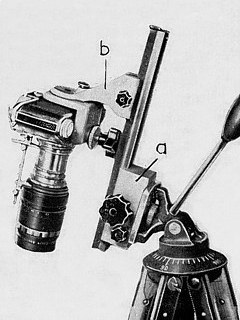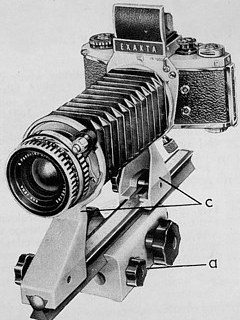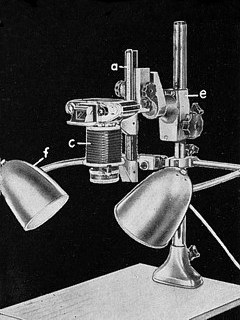|
Exakta: the first SLR system
|
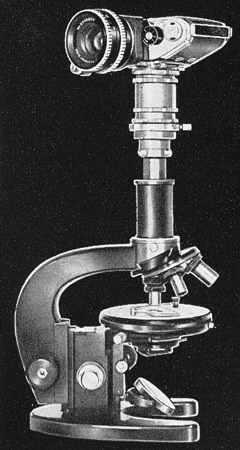
|
In addition to hundreds of lenses available over the years in the Exakta mount, there were dozens of system accessories for Exakta and Exa cameras. Although the existence of those is well known among the collectors, the full list is not easy to come by.
Imagine my delight, when recently my friendly (and cunning) used-camera dealer reached under the counter and handed me a small brochure: "Here, I hate parting with it, but I think you should have this one!"
The brochure was a 1969 catalog of Ihagee Exakta system accessories. The cover said:
|
|
|
Original Exakta Dresden
Additional equipment for
- close-up photography
- transparency copying
- close-up flash techniques
- photography of body cavities
- spectroscopic photography
- microscopic photography
- astrophotography
|
|
|
Note the year: 1969. This was the height of Exakta's reign as a system camera. Ihagee just introduced their most advanced model ever, the VX 1000 with return mirror, and they also offered two simpler ones: the Exa Ia (with interchangeable viewing attachments) and Exa 500 (really the same as model II). The Japanese invasion was still beyond the horizon (if barely), and if there was a single moment in Exakta history with most accessories available — this was it.
Let me jump straight into the catalog, enough to make a hardened Exakta collector drool. All illustrations shown are reproductions from the catalog.
|
|
Extension ring set
The set consists of three screw-in rings (5, 15, and 30 mm) and two bayonet rings: one to mount the extension rings to the camera, and one to fit a lens to the rings. Although each part has its own part number, the catalog is clear that the set was sold only as a whole (Cat. #180).
|
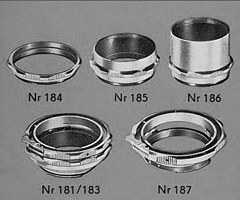
|
The smallest lens extension available with the set is 10 mm (when only the bayonet rings are used). To allow smaller extension, the manufacturer offered a double-bayonet ring, with both male and female lens bayonets in the same part, only 5 mm thick (#187).
The front bayonet ring was also available in a version with an external flange (#192), for use with longer lenses requiring it.
|
|
Small bellows for close-up photography
|
|
This device (#176) provided lens extension from 35 mm to 125 mm. When used with a standard 50 mm lens this results in image magnification from 0.7x to 2.5x (full frame field of 34x51mm or 10x14mm, respectively). It had a tripod socket and a centimeter scale on one of the rails.
The bellows could also be used with a special, sunken-mount aus Jena T 2.8/50mm lens (#128, see below). In such case the extra extension varies from 0 to 90 mm, which means that the lens can be focused all the way up to infinity.
|
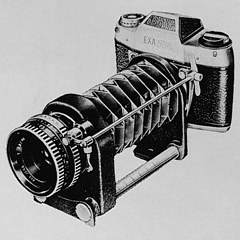
|
|
Shutter release extension
|
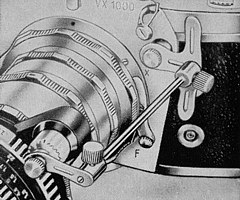
|
Many Exakta lenses (made from the late Fifties on) had external automatic aperture functionality, when a shutter release mounted on the lens was used to close the aperture to the preset value, at the same time activating the actual shutter release on the camera body.
This functionality was, obviously, lost when extension rings or bellows were placed between the lens and the camera. To restore it, a special shutter release extension (#178) was available.
|
|
The Exakta multi-purpose device
This was not really a single piece of equipment but rather a whole family, designed to work together, and available in a number of configurations or as separate items.
|
|
Its basic component was a sliding rail (#155.01U1) on which you could put a rotating camera mount (#155.03); both were sold together as #155.08.
The set also included a larger bellows unit (#155.02) with two mounts riding the rail. It provided extensions from 35 to 220 mm, or image magnifications up to 4.4x (5x8 mm field of view), greater than the small bellows listed above. (The bellows unit was also sold as a set with the rail as #155.10.)
The rail-and-bellows combo, and/or the rotating mount, could be used with a repro stand (#155.16), for which also a light set (#213.12) was available.
|
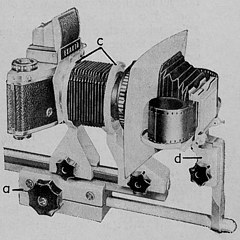
|
Another option for the multi-purpose device was the slide-copying attachment (#155.04 separately, or #155.19 with rail and bellows).
The large bellows would also accept the sunken-mount 2.8/50mm Tessar lens (#128).
|
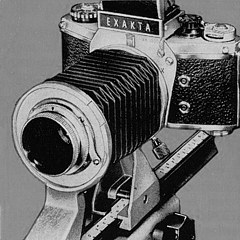
|
|
Lens inversion rings
|
|
For lens extensions corresponding to image magnification greater than 1.5x the manufacturer recommended inverting the lens, i.e., taking pictures with the lens front facing the camera.
To make this possible, Ihagee offered lens-inversion rings, providing the transition from the Exakta bayonet ring to the lens filter thread. The catalog lists three versions: for the filter thread of 35.5, 40.5, and 49 mm (#159/37, #159/42, and #159/51, respectively).
|
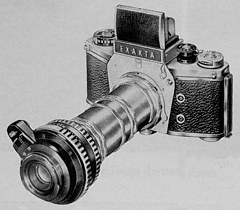
|
|
Viewfinder lens adapter
|
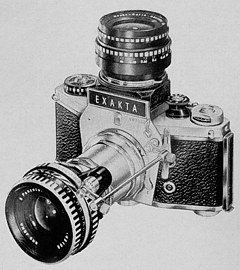
|
This piece (#308.01) fits into the finder well in the camera body; it has a lens bayonet at the top, and takes a standard finder screen. A 50 mm lens can be used as a high-quality magnifier to view the screen; shorter lenses give higher magnifications, but show only the center of the image.
|
|
The contraption makes a great conversation item, and therefore seems to be much sought after by collectors. Ihagee also offered a loupe with a lens bayonet (#312) to be used with it.
|
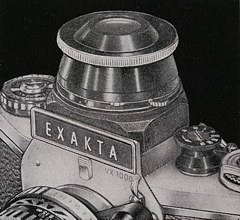
|
|
Light-metering attachment
This was the device (#167) recommended for micro- and macrophotography, when using of an external light meter was difficult if at all possible. It was attached to the camera bayonet mount, and provided such mount for the lens, adding about 20 mm to the lens extension.
|
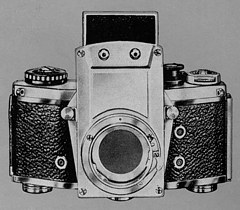
|
A lever was used to move a selenium photocell into the light path and to remove it out of the way before releasing the shutter. A pair of contact sockets was provided for an external ampmeter. The user would take a series of test pictures, record the readings, and then use the recorded settings as needed. Not the most straightforward procedure, compared to today's expectations, but these were the times when you were supposed to know what you were doing.
|
|
Ring flashlights
|
|
There were two such Exakta lights available in 1969, models named RB1 (#196) and RB2 (#197).
With both you were supposed to provide your own power source (400-500V).
|
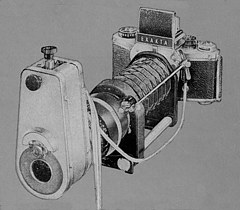
|
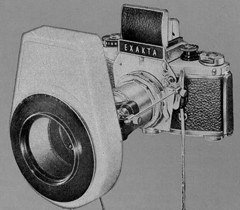
|
|
RB1 had a small diameter; this limited its use to lenses of 100-135mm focal lengths at image magnification of 0.5x and higher. This ring light would fit a 49mm filter thread; it had its own 6V modelling light (as long as you provided your own transformer).
The RB2 ring light had a larger diameter and could be used with 50 mm or longer lenses. You could adjust the exposure by attaching a 58 mm neutral density filter in the provided outer thread, or by using foil filters (provided) in front of the burner.
|
|
The Kolpofot device
This was not really a separate accessory, but rather a package of other accessories which also were available separately.
|
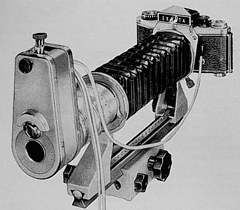
|
Recommended for medical photography, Kolpofot (#155.11) consisted of macro bellows (#155.10), the RB1 ring light (#196), and a special aus Jena S 4.0/135 mm lens (#437A), with manual aperture closing down to f/45, in order to provide maximum depth of field. Alternatively, the set could be ordered as #155.11VSB, with a similar lens sporting an automatic aperture closing down to f/22 (#637).
Kolpofot devices were widely used in early diagnostics of cervical cancer; many stayed in use long after the demise of the Exakta line.
|
|
Accessories for micro-, spectro-, and astrophotography
|
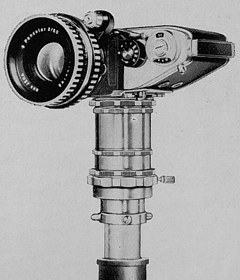
|
For microphotography, Ihagee offered a microscope eyepiece adapter (#153), fitting on the front of extension rings (the camera lens itself was not used in this application).
|
|
Another adapter (#193/1 or #193/2) could be used to mount a micro lens on the front of extension rings, which was recommended for image magnifications greater than 5:1.
|
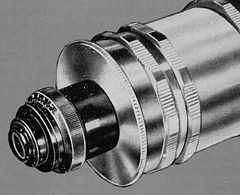
|
|
A telescope adapter (#199) could be used in a similar fashion, connecting a standard 25 mm telescope eyepiece to lens extension rings.
|

|

|
There were also two Jena spectroscope lens adapters (#190 and #191) fitting the 49 mm filter thread.
(The first one is shown at left with the Jena hand spectroscope attached.)
|
|
Ihagee also offered adapters for non-Jena spectroscopes, custom-made as a special order (sending the spectroscope in to Dresden was recommended in such cases).
|
|
Special viewing screens
In macro-, micro-, and astrophotography, the groundglass image is usually too dark to be of much use. The catalog lists a number of special screens useful in such cases (not recommended for general photography):
|
-
A matte glass with a 3 mm clear center plus a cross hair (#302.03);
-
Same, with a 10 mm center combination (#303.04);
-
Clear glass with a cross hair (#303.10);
-
Clear glass with a cross hair and millimeter grid (#303.05).
|

|
|
For old-style finders, ones with the thick (~2 cm) screen/magnifier, Ihagee was offering the same viewing surfaces in thick-screen versions (similar catalog numbers, but with a "302" prefix).
For reproduction photography there was a flat groundglass available (#308.22), without the convex top side, and therefore providing distortion-less viewing.
|
|
The endoscope adapter
|
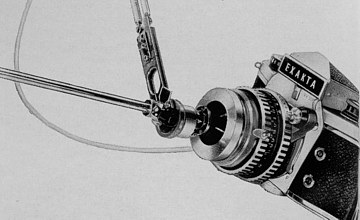
|
For photography of otherwise inaccessible body cavities, Exakta offered an endoscopy attachment (#189). It consisted of a two-piece fixture to fit an eyepiece of a third-party endoscope, and a rotating lens adapter to attach that fixture to a lens filter thread.
Additionally, there was a switch box available (#177), for short-term doubling of the voltage supplied to the standard 12V endoscope light bulb, in order to provide more adequate light for the picture.
|
|
All illustrations have been reproduced from the Exakta 1969 catalog (Polish version).
Reproductions were made with use of the Olympus C-5050Z digital camera.
|




